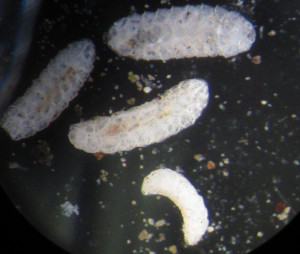
An undescribed species of Contarinia gall midge, collected by the thousands from under a live oak tree.
I recently received a sample of thousands of tiny (1-1/5 mm) maggots collected from a local yard. The sample was collected by Susan Bailey of Plano, who noticed writhing masses of these worm-like critters on her driveway and ground under a live oak tree.
Now anyone who lives around live oaks knows that for the past ten days or so these trees have been showering the world with pollen and the senescent catkins (male flowers). These tiny larvae are occasionally reported under oak trees shortly after flowering.
After consulting with retired USDA entomologist Raymond Gagne, these tiny insects were identified as a type of (unnamed) Contarinia gall fly. As a graduate student, one of the insects I studied was Contarinia sorghicola, the infamous sorghum midge (infamous to sorghum growers anyway). This tiny fly attacks sorghum, and its cousin johnsongrass, only when the plants are shedding pollen. The fly lays an egg inside the developing floret, and feeds on the expanding seed. The result for a sorghum plant is no seeds. This is bad if you grow sorghum.
But the tiny midge that feeds on oaks likely does no harm to the tree, says Gagne. He theorizes that the tiny maggots are likely feeding on sap in the developing flowers. The adult flies, which you wouldn’t see unless you knew what to look for, emerge from the soil and lay their eggs on the flower buds before the catkins open. The larvae that hatch from these eggs feed rapidly, growing to their 1.5 mm full size before they drop from the tree into the ground. Once on the ground they go into diapause, a kind of suspended animation, until the following spring when they pupate and emerge as adults when the tree is ripe once again for attack.
So if you notice something moving amidst the masses of pollen and catkins under your oak tree, don’t panic. You’re witnessing an example of a tiny insect that has learned to adapt to a world in which specialization and competition for resources is everything. You have to admire a creature so attuned to its environment, so specialized, that it knows exactly when during a whole year it must emerge for 5 to 10 days of food. By doing so it avoids competition from other insects and has a reliable source of food and shelter to survive from year to year.
In this time of tight economies and unemployment, I find added appreciation for this tiny midge. With children fresh out of college and looking for career employment, I understand the need to find one’s niche in order to survive. It’s a tough world out there. We appear to have at least that in common with the oak gall midge.
